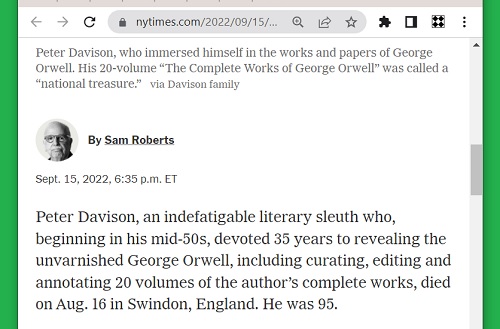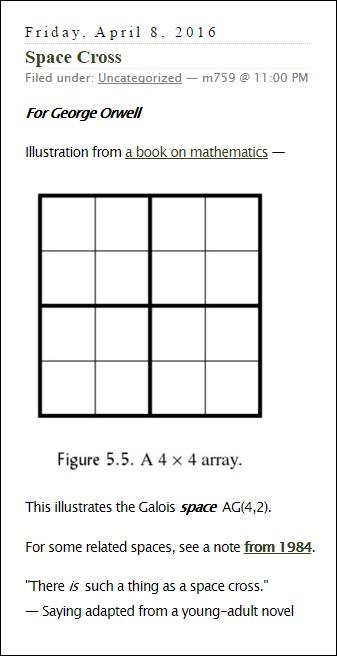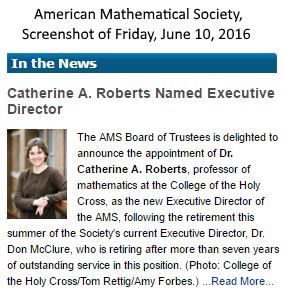See the previous post and London Bondage.
Thursday, September 28, 2023
Saturday, August 25, 2018
“Waugh, Orwell. Orwell, Waugh.”
Suggested by a review of Curl on Modernism —
Related material —
Waugh + Orwell in this journal and …
Friday, August 4, 2023
Kinbotean Annotation (Continued)
Tuesday, July 11, 2023
|
For some illuminating remarks on Kinbotean annotation, see
Chapter 6 (Nabokov, Lowry, Orwell) of The Wreath of Wild Olive ,
by Mihai Spariosu.
(Published by State University of New York Press,
© 1997 State University of New York.)
Thursday, September 15, 2022
Monday, June 22, 2020
Serious Leary
The director of the 2007 film “The Number 23” reportedly died today.
In his memory — An image that appeared in the Leary link of last night’s
post on “a combination of Kafka and Joyce, with a touch of Orwell” —
Sunday, June 21, 2020
Equals
“A love story of epic, epic, epic proportion” — Kristen Stewart on “Equals”
“Some things are more equal than others.” — Adapted from Orwell
Sunday, June 2, 2019
Working Backward
The title is from a search in this journal —
http://www.m759.net/wordpress/?s=1982+Janine .
Thursday, May 16, 2019
A Pure Geometry
Tuesday, April 2, 2019
Linked-to Review, Courtesy of Peter Woit Today . . .
Tuesday, April 4, 2017
Friday, June 10, 2016
Friday, April 8, 2016
Space Cross
For George Orwell
Illustration from a book on mathematics —

This illustrates the Galois space AG(4,2).
For some related spaces, see a note from 1984.
"There is such a thing as a space cross."
— Saying adapted from a young-adult novel
Monday, August 31, 2015
Stylist
Or: A Shema for Sacks.
"We’ve already seen the hexagon painted over a
propaganda poster. It’s obviously a mark of defiance,
or maybe a geometry lesson. It’s still not clear.
Hey, it’s that clown dictator again. Who’s his stylist?"
Saturday, September 20, 2014
The Metaphysics of Entities
Anthony Lane in The New Yorker , issue dated Sept. 22, 2014:
"The hero of 'The Zero Theorem' is a computer genius called Qohen Leth
(Christoph Waltz)…. He is the sole resident of a derelict church, where,
on a crucifix in front of the altar, the head of Christ has been replaced by
a security camera. No prayers are ever said, and none are answered.
In short, the place is deconsecrated, but to claim that it lacks any spark of
sacred yearning would be wrong, because Qohen devotes his days to seeking
the Zero Theorem, which—whatever it may be—lies at the fuzzy limit of
human powers. “We crunch entities,” he says, as if that explained anything.
His employer is Mancom, a large corporation that, in Orwellian fashion,
oversees ordinary lives, although it betrays more frantic desperation than
glowering threat."
One approach to the metaphysics of entities was indicated in the previous
post, 'Metaphysics for Gilliam." A different approach:
"Categories, Sets, and the Nature of Mathematical Entities,"
by Jean-Pierre Marquis, Ch. 13, pp. 181-192, in the 2006 book
The Age of Alternative Logics , ed. by van Benthem et al.
(Springer, Netherlands).
From pages 182-183 —
13.2 The nature of mathematical entities
Let us start with the nature of mathematical entities in general and with a
rough and classical distinction that will simply set the stage for the picture we
want to develop. We essentially follow Lowe 1998* for the basic distinctions. We
need to distinguish between abstract and concrete entities, on the one hand, and
universals and particulars on the other hand. For our purpose, it is not necessary
to specify a criterion of demarcation between abstract and concrete entities. We
simply assume that such a distinction can be made, e.g. concrete entities can
change whereas abstract entities cannot. We assume that a universal is an entity
that can be instantiated by entities which themselves are not instantiable, the
latter being of course particulars. Given these distinctions, an entity can be a
concrete particular, a concrete universal, an abstract particular or an abstract
universal.
Our focus here is between the last two possibilities. For we claim that the
current conception of sets makes them abstract particulars whereas for objects
defined within categories, mathematical entities are abstract universals. This,
we claim, is true of category theory as it is.
* Lowe, E.J., 1998, The Possibility of Metaphysics , Oxford: Clarendon Press.
Wednesday, January 8, 2014
Not Subversive, Not Fantasy
The title refers to that of today's previous post, which linked to
a song from the June 1, 1983, album Synchronicity .
(Cf. that term in this journal.)
For some work of my own from the following year, 1984, see…
… as well as the Orwellian dictum Triangles Are Square.
(The cubical figure at left above is from the same month,
if not the same day, as Synchronicity — June 21, 1983.)
Sunday, November 24, 2013
Monday, August 19, 2013
Midnight in the Garden
From a 2003 interview by Paul Devlin (PD) with poet John Hollander (JH),
who reportedly died Saturday—
|
PD: You wrote in the introduction to the new edition of Reflections on Espionage that whenever you have been "free of political callowness" it was partly as a result of reading W.H. Auden, George Orwell, and George Bernard Shaw. Do you think these writers might possibly be an antidote to political callowness that exists in much contemporary literary criticism? JH: If not they, then some other writers who can help one develop within one a skepticism strongly intertwined with passion, so that each can simultaneously check and reinforce the other. It provides great protection from being overcome by blind, true-believing zeal and corrupting cynicism (which may be two sides of the same false coin). Shaw was a great teacher for many in my generation. I started reading him when I was in sixth grade, and I responded strongly not only to the wit but to various modes, scene and occasions of argument and debate as they were framed by various kinds of dramatic situation. I remember being electrified when quite young by the moment in the epilogue scene of Saint Joan when the English chaplain, De Stogumber, who had been so zealous in urging for Joan’s being burned at the stake, returns to testify about how seeing her suffering the flames had made a changed man of him. The Inquisitor, Peter Cauchon, calls out (with what I imagined was a kind of moral distaste I’d never been aware of before), "Must then a Christ perish in torment in every age to save those who have no imagination?" It introduced me to a skepticism about the self-satisfaction of the born-again, of any persuasion. With Auden and Orwell, much later on and after my mental world had become more complicated, it was education in negotiating a living way between a destructively naïve idealism and the crackpot realism—equally inimical to the pragmatic. PD: Would you consider yourself a "formal" pragmatist, i.e., a student of Peirce, James, Dewey, Mead (etc.) or an "informal" pragmatist – someone taking the common-sense position on events…or someone who refuses to be pigeon-holed politically? JH: "Informal" – of the sort that often leads me to ask of theoretical formulations, "Yes, but what’s it for ?" PD: Which other authors do you think might help us negotiate between "naïve idealism" and "crackpot realism"? I think of Joyce, Wallace Stevens, perhaps Faulkner? JH: When I was in college, a strong teacher for just this question was Cervantes. One feels, in an Emersonian way, that the Don’s view of the world is correct at midnight, and Sancho’s at noon. |
Then there is mathematical realism.
A post in this journal on Saturday, the reported date of Hollander's death,
discussed a possible 21st-century application of 19th-century geometry.
For some background, see Peter J. Cameron's May 11, 2010, remarks
on Sylvester's duads and synthemes . The following figure from the
paper discussed here Saturday is related to figures in Cameron's remarks.

Thursday, June 13, 2013
Window
From Jim Holt’s Aug. 29, 2008, review of
The Same Man:
George Orwell and Evelyn Waugh in Love and War
by David Lebedoff
“Orwell thought ‘good prose is like a window pane,’
forceful and direct. Waugh was an elaborate stylist
whose prose ranged from the dryly ironical to the
richly ornamented and rhetorical. Orwell was solitary
and fiercely earnest. Waugh was convivial and
brutally funny. And, perhaps most important, Orwell
was a secularist whose greatest fear was the
emergence of Big Brother in this world. Waugh was
a Roman Catholic convert whose greatest hope lay
with God in the next.”
The Orwell quote is from “Why I Write.”
A search for the original yields…
Detail:

Synchronicity:
See, too, in this journal the
Chinese character for “field”—
Tuesday, November 6, 2012
Bend Sinister
This morning's New York Times obituaries—
These suggest a look at Solving Nabokov's Lolita Riddle ,
by Joanne Morgan (Sydney: Cosynch Press, 2005).
That book discusses Lolita as a character like Lewis Carroll's Alice.
(The Red Queen and Alice of course correspond to figures in
the first two thumbnails above.)
From the obituary associated with the third thumbnail above:
"Front-page headlines combined concision and dark humor."
The title of this post, Bend Sinister , is not unlike such a headline.
It is the title of a novel by Nabokov (often compared with Orwell's 1984 )
that is discussed in the Lolita Riddle book.
Related material— The bend sinister found in Log24 searches
for Hexagram 14 and for the phrase Hands-On—
 |
 |
Saturday, February 18, 2012
Logo
Pentagram design agency on the new Windows 8 logo—
"… the logo re-imagines the familiar four-color symbol
as a modern geometric shape"—

Sam Moreau, Principal Director of User Experience for Windows,
yesterday—
On Redesigning the Windows Logo—
"To see what is in front of one's nose
needs a constant struggle." —George Orwell
That is the feeling we had when Paula Scher
(from the renowned Pentagram design agency)
showed us her sketches for the new Windows logo.
Related material:
- A Four-Color Theorem,
- The Galois Window, and
-
An illustration from
Finite Geometry of the Square and Cube—

Sunday, August 7, 2011
Reflection Group
The European Reflection Group report of Saturday, May 8, 2010—
"Project Europe 2030: Challenges and Opportunities" (pdf, 46 pp.)—
"All our members agree on one fundamental issue:
Europe is currently at a turning point in its history."
This journal on the same date— "A Better Story"—
"…I can imagine the decisive evolutionary beginnings of humans and societies… not in an adult version, but in the playful mentality of children…. An unlikely story? Perhaps. I am looking out for a better story."
– Hans G. Furth, Desire for Society: Children's Knowledge as Social Imagination, published by Springer, 1996, p. 181
"The clocks were striking thirteen." — George Orwell
See also this journal during the rest of May 2010 and "Sermon" from Sunday, February 20, 2011.
Sunday, February 20, 2011
Sermon
From Galleri MGM in Oslo —
A connection to today's earlier post, Sunday School— The Oslo Version, from Friday, May 21, 2010.
Lyche's "Omega Point" portal, together with her last name, suggested three posts from the following Saturday morning— which later proved to be the date of Martin Gardner's death—
Art Space, Through the Lyche Gate and The Lyche Gate Asterisk.
For some further religious remarks, see November 9th, 2010— A Theory of Pure Design.
Monday, June 21, 2010
1984 Story (continued)
This journal’s 11 AM Sunday post was “Lovasz Wins Kyoto Prize.” This is now the top item on the American Mathematical Society online home page—
For more background on Lovasz, see today’s
previous Log24 post, Cube Spaces, and also
Cube Space, 1984-2003.
“If the Party could thrust its hand into the past and
say of this or that event, it never happened….”
— George Orwell, 1984
Tuesday, January 5, 2010
Artifice of Eternity
A Medal
In memory of Byzantine scholar Ihor Sevcenko,
who died at 87 on St. Stephen's Day, 2009–
| William Grimes on Sevcenko in this morning's New York Times:
"Perhaps his most fascinating, if uncharacteristic, literary contribution came shortly after World War II, when he worked with Ukrainians stranded in camps in Germany for displaced persons. In April 1946 he sent a letter to Orwell, asking his permission to translate 'Animal Farm' into Ukrainian for distribution in the camps. The idea instantly appealed to Orwell, who not only refused to accept any royalties but later agreed to write a preface for the edition. It remains his most detailed, searching discussion of the book." |
See also a rather different medal discussed
here in the context of an Orwellian headline from
The New York Times on Christmas morning,
the day before Sevcenko died.
That headline, at the top of the online front page,
was "Arthur Koestler, Man of Darkness."

The medal, offered as an example of brightness
to counteract the darkness of the Times, was designed
by Leibniz in honor of his discovery of binary arithmetic.
See Brightness at Noon and Brightness continued.
"By groping toward the light we are made to realize
how deep the darkness is around us."
— Arthur Koestler, The Call Girls: A Tragi-Comedy,
Random House, 1973, page 118
Monday, December 28, 2009
Brightness at Noon, continued
This journal’s Christmas Day entry, Brightness at Noon, was in response to the Orwellian headline “Arthur Koestler, Man of Darkness,” at the top of the online New York Times front page on Christmas morning.
The entry offered, as an example of brightness, some thoughts of Leibniz on his discovery of binary arithmetic.
Related material:
“To make all things from nothing, unity suffices.” So it is written on a medal entitled Imago Creationis and designed by Leibniz to “exhibit to posterity in silver” his discovery of the binary system. Baron Gottfried Wilhelm von Leibniz (also Leibnitz) 1646-1716. Philosopher and mathematician. Invented calculus independently of Newton. Proposed the metaphysical theory that we live in “the best of all possible worlds.” He also discovered binary number system and believed in its profound metaphysical significance. He noticed similarity with the ancient Chinese divination system “I Ching.” We chose him for our patron, for Krawtchuk polynomials can be understood as a sophistication of the simple counting of 0 and 1… — Philip Feinsilver and Jerzy Kocik, 17 July 2001 |
From Mikhail Krawtchouk: Short Biography—
Anyone knowing even a little Soviet history of the thirties can conclude that Krawtchouk could not avoid the Great Terror. During the Orwellian “hours of hatred” in 1937 he was denounced as a “Polish spy,” “bourgeois nationalist,” etc. In 1938, he was arrested and sentenced to 20 years of confinement and 5 years of exile.
Academician Krawtchouk, the author of results which became part of the world’s mathematical knowledge, outstanding lecturer, member of the French, German, and other mathematical societies, died on March 9, 1942, in Kolyma branch of the GULAG (North-Eastern Siberia) more than 6 months short of his 50th birthday.
Incidentally, happy birthday
to John von Neumann.
Sunday, September 7, 2008
Sunday September 7, 2008
Sunday, November 6, 2005
Sunday November 6, 2005
For Mike Nichols,
whose birthday is today:
Angels in Arabia
Yesterday’s entries discussed an angel and a fugue; this suggests Clive Barker’s classic tale Weaveworld, which in turn suggests the following links:
1. the Log24 archive,
Aug. 1-6, 2005, and
2. C. S. Lewis, George Orwell, and
the Corruption of Language,
an essay at the website of
St. Christopher’s Cathedral
in Bahrain, Arabia.
Nichols, who is Jewish, may of course prefer the following remark of comedian Sarah Silverman:
“I wear this St. Christopher medal sometimes because– I’m Jewish, but my boyfriend is Catholic– it was cute the way he gave it to me. He said if it doesn’t burn through my skin it will protect me.”
Tuesday, June 7, 2005
Tuesday June 7, 2005
101 101
writes Dominique de Villepin,
the new French Prime Minister,
“shines like a powder trail
on a day’s horizon.
It sets it ablaze all at once,
explodes all limits,
draws the eyes
to other heavens.”
— Ben Macintyre,
The London Times, June 4:
When Rimbaud Meets Rambo
“Room 101 was the place where
your worst fears were realised
in George Orwell’s classic
Nineteen Eighty-Four.
Professor Nash’s office number
in the movie ‘A Beautiful Mind.'”
Classics Illustrated —

Click on picture for details.
(For some mathematics that is actually
from 1984, see Block Designs
and the 2005 followup
The Eightfold Cube.)
Tuesday, September 30, 2003
Tuesday September 30, 2003
Project for the
New Century
“A bully can be stopped, and so can a mob. It takes one person with the courage and a resolute voice.”
— Tim Robbins, speech to National Press Club, April 15, 2003
Resoluteness is a necessary, but not sufficient, condition for such a voice. Also needed is eloquence. Here is such a voice:
Postscript:
I wrote the above at 3:38 PM today, thinking I had finally found someone to admire whom my left-leaning friends might also admire.
Perhaps resoluteness and eloquence suffice to stop a mob; they are not, however, sufficient to impress professional journalists, who, to be much impressed, require a third quality– truthfulness.
Since today’s major Washington and New York papers indicate that a presidential scandal of Water- or Monica-gate proportions may be in the offing, some minimal fact-checking seems in order. Hence, at 3:40 PM today, I did a Google search on names Pitt discusses:
“karl rove”
“robert mosbacher”
novak.
That search indicates that unfortunately, mob-stopper Pitt seems, like many leftists, to be a liar.
Here is an excerpt from Pitt on Karl Rove dated Tuesday, Sept. 30, 2003:
The Most Insidious of Traitors
“Karl Rove, senior political advisor to George W. Bush, is a very powerful man. That is not to say he has never been in trouble. Rove was fired from the 1992 Bush Sr. campaign for trashing Robert Mosbacher, Jr., who was the chief fundraiser for the campaign and an avowed Bush loyalist. Rove accomplished this trashing of Mosbacher by planting a negative story with columnist Bob Novak. The campaign figured out that Karl had done the dirty deed, and he was given his walking papers.
Demonstrably, Rove is back in the saddle again. The January 2003 edition of Esquire magazine carried an article by Ron Suskind…. “
Here is an excerpt from columnist Robert Novak dated December 5, 2002:
“The article in Esquire’s January edition by Pulitzer Prize-winning journalist Ron Suskind is actually about Karl Rove, Bush’s powerful political adviser….
Unfortunately, I did not escape Suskind’s article, which includes these sentences: ‘Sources close to the former president say Rove was fired from the 1992 Bush presidential campaign after he planted a negative story with columnist Robert Novak about dissatisfaction with campaign fund-raising chief and Bush loyalist Robert Mosbacher Jr. It was smoked out, and he was summarily ousted.’ I was called by no fact-checker, who would have learned of multiple errors.
Suskind has confused former Secretary of Commerce Robert Mosbacher Sr., Bush’s 1992 chief fund-raiser, with his son Rob, who headed the Bush campaign in Texas (Victory ’92). Criticism of the younger Mosbacher, a frequent unsuccessful candidate in Texas, was not ‘planted’ with me by Rove but was passed to me by a Bush aide whom I interviewed. Rove was indeed fired by Mosbacher from Victory ’92 but continued as a national Bush-for-president operative.
Three mistakes in two sentences lend credence to claims by White House aides that they were misrepresented in Suskind’s July article…”
I say Pitt seems to be lying because in today’s editorial he never even mentions Novak’s column of December 5, 2002, which is, as noted above, readily available.
It is, of course, possible that Pitt and Suskind are right and Novak is wrong. It is also possible that Orwell was wrong, that Stalin was a great man, and that Communism is the wave of the future.
Sunday, June 29, 2003
Sunday June 29, 2003
Every Boy Has a Daddy
Today is the Feast of Saint Peter.
The most timely quote I know of for today’s religious observances is from Oh What a Web They Weave, by F. John Loughnan:
This was written as part of an attack on the father of a Latin-Mass Catholic who authored the website Ecclesia Militans, which has the logo
Note the resemblance to the Iron Cross.
Soldier of Fortune magazine, April 2002, contains a brief discussion of the German motto “Gott mit uns” that is relevant to the concept of The Church Militant.
Soldier of Fortune,
April 2002
The actor on the cover, Mel Gibson, also serves to illustrate our meditation for today, “Every boy has a daddy.” See Christopher Noxon’s article in the New York Times Magazine of March 9, 2003:
Noxon attacks Gibson’s father Hutton — like his son Mel, a Latin-Mass Catholic, and author of
A related “Every boy has a daddy” attack appears in the June 2003 issue of Playboy magazine. An entertaining excerpt from this attack on Joseph P. Kennedy, father of JFK, may be found at Orwell Today.
Finally, let us meditate on the ultimate “Every boy has a daddy” attack — by novelist Robert Stone on the alleged father of Jesus of Nazareth:
|
Excerpt from From the mosques, from the alleys, from the road: “Allahu Akbar!” …. Then a voice shouted: “Itbah al-Yahud!” …. Kill the Jew! …. “Itbah al-Yahud!” the crowd screamed…. Then Lucas saw the things they had taken up: trowels and mallets and scythes, some dripping blood. Everyone was screaming, calling on God. On God, Lucas thought. He was terrified of falling, of being crushed by the angry swarm that was whirling around him. He wanted to pray. “O Lord,” he heard himself say. The utterance filled him with loathing, that he was calling on God, on that Great Fucking Thing, the Lord of Sacrifices, the setter of riddles. Out of the eater comes forth meat. The poser of parables and shibboleths. The foreskin collector, connoisseur of humiliations, slayer by proxy of his thousands, his tens of thousands. Not peace but a sword. The Lunatic Spirit of the Near East, the crucified and crucifier, the enemy of all His own creation. Their God-Damned God. |
The New York Times Magazine article mentioned above was prompted, in part, by Mel Gibson’s current movie production, “The Passion,” about the final 12 hours in the (first, or possibly second) life of Jesus. If I were producing a Passion play, as Peter I would certainly cast Stone.
See also the 11 PM sequel to the above.
Friday, April 18, 2003
Friday April 18, 2003
To the Society of Jesus (also known as the Jesuits):
Have a Good Friday, Traitors

†
Prompted by Pilate’s question “What is truth?” and by my March 24 attack on Noam Chomsky, I decided this afternoon to further investigate what various people have written about Chomsky’s posing of what he calls “Plato’s problem” and “Orwell’s problem.” The former concerns linguistics, the latter, politics. As my March 24 entry indicates, I have nothing but contempt for both Chomsky’s linguistics and Chomsky’s politics. What I discovered this afternoon is that Georgetown University, a Jesuit institution, in 2001 appointed a Chomskyite, David W. Lightfoot, as Dean of the Graduate School of Arts and Sciences.
“Why do we know so much more than we have evidence for in certain areas, and so much less in others? In tackling these questions — Plato’s and Orwell’s problem — Chomsky again demonstrates his unequalled capacity to integrate vast amounts of material.” — David W. Lightfoot, review of Chomsky’s Knowledge of Language
What, indeed, is truth? I doubt that the best answer can be learned from either the Communist sympathizers of MIT or the “Red Mass” leftists of Georgetown. For a better starting point than either of these institutions, see my note of April 6, 2001, Wag the Dogma.
See, too, In Principio Erat Verbum, which notes that “numbers go to heaven who know no more of God on earth than, as it were, of sun in forest gloom.”
Since today is the anniversary of the death of MIT mathematics professor Gian-Carlo Rota, an example of “sun in forest gloom” seems the best answer to Pilate’s question on this holy day. See
“Examples are the stained glass windows of knowledge.” — Vladimir Nabokov
Motto of Plato’s Academy
† The Exorcist, 1973
Monday, March 24, 2003
Monday March 24, 2003
Orwell’s question, according to
an admirer of leftist Noam Chomsky:
“When so much of the BS is right out in the open,
why is it that we know so little about it?
Why don’t we see what’s right in front of our eyes?”
 Oscar |
Lying, Truth-Telling, and the Social Order |
 Michael Moore |
“First of all, I’d like to thank the Academy….”
— Quotation attributed to Plato
The New Yorker of March 31, 2003, discusses leftist academic Noam Chomsky. The online edition provides a web page listing pro-Chomsky links.
Chomsky’s influence is based in part on the popularity of his half-baked theories on linguistics, starting in the 1950’s with “deep structure” and “transformational,” or “generative,” grammar.
Chomsky has abandoned many of his previous ideas and currently touts what he calls The Minimalist Program.
For some background on Chomsky’s recent linguistic notions, see the expository essay “Syntactic Theory,” by Elly van Gelderen of the Arizona State University English Department. Van Gelderen lists her leftist political agenda on her “Other Interests” page. Her department may serve as an example of how leftists have converted many English departments in American universities to propaganda factories.
Some attacks on Chomsky’s scholarship:
Forty-four Reasons Why the Chomskians Are Mistaken
Chomsky’s (Mis)Understanding of Human Thinking
Anatomy of a Revolution… Chomsky in 1962
…Linguistic Theory: The Rationality of Noam Chomsky
Some attacks on Chomsky’s propaganda:
Destructive Generation excerpt
Partners in Hate: Noam Chomsky and the Holocaust Deniers
Chomsky and Plato’s Diamond

Like another purveyor of leftist nonsense, Jacques Derrida, Chomsky is fond of citing Plato as a precedent. In particular, what Chomsky calls “Plato’s problem” is discussed in Plato’s Meno. For a look at the diamond figure that plays a central role in that dialogue, see Diamond Theory. For an excellent overview of related material in Plato, see Theory of Forms.
Wednesday, January 1, 2003
Wednesday January 1, 2003
|
ART WARS: That Old Devil Moon |
|
From The New York Times, Wed., Jan. 1, 2003:
Richard Horner, 82,
Broadway Producer, Is DeadRichard Horner, a Broadway theater owner and producer who won a Tony Award for the 1974 revival of Eugene O'Neill's "Moon for the Misbegotten," died on Saturday [December 28, 2002] at his home in Palm Springs, Calif. He was 82.
According to one source, the O'Neill revival opened on December 28, 1973 — the same date on which the life of one of its producers was later to close.
From a CurtainUp review:
The revival at the Morosco was dubbed by its company "The Resurrection Play" since Jason Robards undertook the part just after a near fatal car accident and its legendary director José Quintero had just given up drinking.
According to the Internet Broadway Database, this revival, or resurrection, took place officially not on December 28 — the date of Horner's death — but, appropriately, a day later.
At any rate, O'Neill's title, along with my weblog entry of December 28, 2002,
"On This Date," featuring Kylie Minogue,
suggests the following mini-exhibit of artistic efforts:
|
Curtain Up!
July 2000
|

|
|
Under the Volcano: A painting based on Malcolm Lowry's classic novel. Having played tennis, Dr. Vigil and M. Laruelle talk about the events a year earlier. The view is of Cuernavaca from the Casino de la Selva hotel.
Painting by
|

|
For further details on Kylie, Mexico, tequila, and
Under the Volcano,
see my entry of November 5, 2002.
For today's site music, click "Old Devil Moon" here.
|
Addendum of 9:30 pm 1/1/03:
For a politically correct view
For a more perceptive analysis,
If there is a devil here,
J. D. Salinger (Nine Stories),
Frazer might appreciate the remarks in
Not amused: Charlotte Raven
Raven, take a bough.
|
Thursday, October 17, 2002
Thursday October 17, 2002
To the Green Lady
of Perelandra
View from the slopes of Slieve na mBan
In honor of the relationship between theology and literature, of the Green Lady of C. S. Lewis, and of…
John Flood BA, MA (NUI), Ph.D. (Dublin)
Senior Lecturer. Formerly a tutor at the National University of Ireland, Maynooth, and Trinity College, Dublin, his Ph.D. was on the influence of the interpretation of the figure of Eve in Early Modern writing. His research interests include the Renaissance, George Orwell, J. R. R. Tolkien and the relationship between theology and literature.
… this site’s music is now Caoine Cill Chais, The Lament for Kilcash.





























